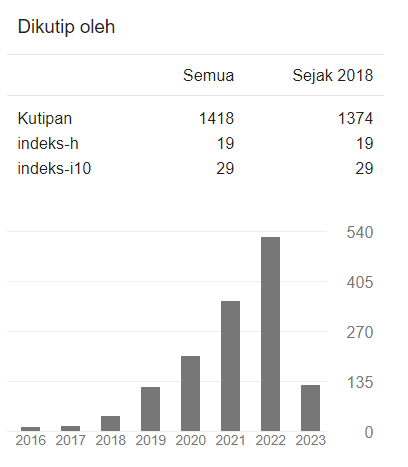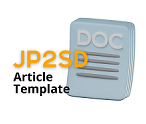The Effect Of Flash-Based Interactive Learning Multimedia On The Thematic Learning Outcomes Of Grade 5 Students In Elementary School
DOI:
https://doi.org/10.22219/jp2sd.v10i1.20026Abstract
This study aims to determine the effect of flash-based interactive multimedia learning on the fifth-grade elementary school students' thematic integrative learning outcomes. The study is a quantitative study with a True Experimental Design type of posttest-only control design. The population was 180 fifth-grade students, with 40 fifth-grade students chosen as samples using cluster sampling. The data collection used multiple-choice questions to measure the results of integrative thematic learning of the experimental and control class. The hypothesis test used is t-test. The results of the t-test analysis show that flash-based interactive multimedia learning affects the integrative thematic learning outcomes of fifth-grade elementary school students
Downloads
References
Afiani, K. D. A., & Faradita, M. N. (2021). Analisis Aktivitas Siswa dalam Pembelajaran Daring Menggunakan Ms . Teams pada Masa Pandemi Covid-19. Jurnal Pemikiran Dan Pengembangan Sekolah Dasar, 9(1), 16–27.
Batka, J. A., & Peterson, S. A. (2005). The effects of individual differences in working memory on multimedia learning. Proceedings of the Human Factors and Ergonomics Society, 1256–1260. https://doi.org/10.1177/154193120504901309
Björklund, C., & Ahlskog-Björkman, E. (2017). Approaches to teaching in thematic work: early childhood teachers’ integration of mathematics and art. International Journal of Early Years Education, 25(2), 98–111. https://doi.org/10.1080/09669760.2017.1287061
Boslaugh, S. (2013). Tufts University. Green Education: An A-to-Z Guide, August. https://doi.org/10.4135/9781412974615.n106
Çakiroğlu, Ü., Güler, M., Atabay, M., & Güler, M. (2020). Connections Between Learning Styles and Perceived Cognitive Load in Multimedia Learning: An Experimental Study. Journal of Educational Technology Systems, 48(4), 553–573. https://doi.org/10.1177/0047239519844509
Domagk, S., Schwartz, R. N., & Plass, J. L. (2010). Interactivity in multimedia learning: An integrated model. Computers in Human Behavior, 26(5), 1024–1033. https://doi.org/10.1016/j.chb.2010.03.003
Dyah Worowirastri Ekowati dkk. (2021). Gerakan Literasi Sekolah Selama Belajar Dari Rumah Bagi Siswa Sekolah Dasar. Jp2Sd (Jurnal Pemikiran Dan Pengembangan Sekolah Dasar), 9(2), 198–207.
Greer, D. L., Crutchfield, S. A., & Woods, K. L. (2013). Cognitive Theory of Multimedia Learning, Instructional Design Principles, and Students with Learning Disabilities in Computer-based and Online Learning Environments. Journal of Education, 193(2), 41–50. https://doi.org/10.1177/002205741319300205
Hakim, A. R., & Windayana, H. (2016). Pengaruh Penggunaan Multimedia Interaktif Dalam Pembelajaran Matematika Untuk Meningkatkan Hasil Belajar Siswa SD. EduHumaniora | Jurnal Pendidikan Dasar Kampus Cibiru, 4(2). https://doi.org/10.17509/eh.v4i2.2827
Hernaningtyas, I. S., Susetyarini, R. E., & Widodo, R. (2016). Pengembangan Multimedia Interaktif Ceria (Mic) Pembelajaran Tematik Di Sekolah Dasar. Jurnal Pemikiran Dan Pengembangan Sekolah Dasar (JP2SD), 1(4), 256. https://doi.org/10.22219/jp2sd.vol1.no4.256-266
Hidayah, N., Pgmi, J., Tarbiyah, F., & Keguruan, D. (2015). Tematik Sd. TERAMPIL Pendidikan Dan Pembelajaran Dasar, 2, 34–49.
Izmirli, S., & Kurt, A. A. (2016). Effects of Modality and Pace on Achievement, Mental Effort, and Positive Affect in Multimedia Learning Environments. Journal of Educational Computing Research, 54(3), 229–235. https://doi.org/10.1177/0735633115621921
khairani, majidah. (2016). Pengembangan Media Pembelajaran Dalam Bentuk Macromedia Flash Materi Tabung Untuk Smp Kelas Ix. Jurnal Iptek Terapan, 10(2), 95–102. https://doi.org/10.22216/jit.2016.v10i2.422
Khan, F. M. A., & Masood, M. (2015). The Effectiveness of an Interactive Multimedia Courseware with Cooperative Mastery Approach in Enhancing Higher Order Thinking Skills in Learning Cellular Respiration. Procedia - Social and Behavioral Sciences, 176, 977–984. https://doi.org/10.1016/j.sbspro.2015.01.567
Kingry, M. A., Havard, B., Robinson, R., & Islam, M. (2015). Instructional Fading and Student Performance in Principles of Accounting Instruction. Journal of Educational Technology Systems, 44(1), 53–68. https://doi.org/10.1177/0047239515598519
Lee, A. Y. L. (2016). Media education in the School 2.0 era: Teaching media literacy through laptop computers and iPads. Global Media and China, 1(4), 435–449. https://doi.org/10.1177/2059436416667129
Lee, T. T., & Osman, K. (2012). Interactive Multimedia Module in the Learning of Electrochemistry: Effects on Students’ Understanding and Motivation. Procedia - Social and Behavioral Sciences, 46, 1323–1327. https://doi.org/10.1016/j.sbspro.2012.05.295
Liu, H. C. (2018). Investigating the Impact of Cognitive Style on Multimedia Learners’ Understanding and Visual Search Patterns: An Eye-Tracking Approach. Journal of Educational Computing Research, 55(8), 1053–1068. https://doi.org/10.1177/0735633117697020
Molina, A. I., Navarro, Ó., Ortega, M., & Lacruz, M. (2018). Evaluating multimedia learning materials in primary education using eye tracking. Computer Standards and Interfaces, 59(February), 45–60. https://doi.org/10.1016/j.csi.2018.02.004
Rahimi, M., & Allahyari, A. (2019). Effects of Multimedia Learning Combined With Strategy-Based Instruction on Vocabulary Learning and Strategy Use. SAGE Open, 9(2). https://doi.org/10.1177/2158244019844081
Russell, A., & Hannon, D. (2012). A cognitive load approach to learner-centered design of digital instructional media and supporting accessibility tools. Proceedings of the Human Factors and Ergonomics Society, 556–560. https://doi.org/10.1177/1071181312561116
Shilpa, S., & Sunita, M. (2016). A Study an Interactive Elementary Education ( 3-6 ) With Multimedia. International Journal of Home Science, 2(1), 214–215.
Sugiyono. (2017). Metode Penelitian Kuantitatif, Kualittif, dan R&D. alfabeta.
Sumarsih, S., & Mukminan, M. (2016). Pengembangan Multimedia Akuntansi Biaya Metode Harga Pokok Pesanan Bagi Mahasiswa Jurusan Pendidikan Akuntansi Uny. Jurnal Inovasi Teknologi Pendidikan, 3(1), 92. https://doi.org/10.21831/tp.v3i1.8266
Umam, K. (2016). Pengaruh Menggunakan Software Macromedia Flash 8 Terhadap Hasil Belajar Matematika Siswa Kelas Viii. KALAMATIKA Jurnal Pendidikan Matematika, 1(1), 84. https://doi.org/10.22236/kalamatika.vol1no1.2016pp84-92
Downloads
Published
Issue
Section
License
Copyright (c) 2022 Jurnal Pemikiran dan Pengembangan Sekolah Dasar (JP2SD)

This work is licensed under a Creative Commons Attribution-ShareAlike 4.0 International License.
Authors who publish with Jurnal Pemikiran dan Pengembangan Sekolah Dasar (JP2SD) agree to the following terms:
- For all articles published in Jurnal Pemikiran dan Pengembangan Sekolah Dasar (JP2SD), copyright is retained by the authors. Authors give permission to the publisher to announce the work with conditions. When the manuscript is accepted for publication, the authors agree to automatic transfer of the publishing right to the publisher.
- Authors retain copyright and grant the journal right of first publication with the work simultaneously licensed under a Creative Commons Attribution-ShareAlike 4.0 International License that allows others to share the work with an acknowledgment of the work's authorship and initial publication in this journal.
- Authors are able to enter into separate, additional contractual arrangements for the non-exclusive distribution of the journal's published version of the work (e.g., post it to an institutional repository or publish it in a book), with an acknowledgment of its initial publication in this journal.
- Authors are permitted and encouraged to post their work online (e.g., in institutional repositories or on their website) prior to and during the submission process, as it can lead to productive exchanges, as well as earlier and greater citation of published work (See The Effect of Open Access).

This work is licensed under a Creative Commons Attribution-ShareAlike 4.0 International License.


















